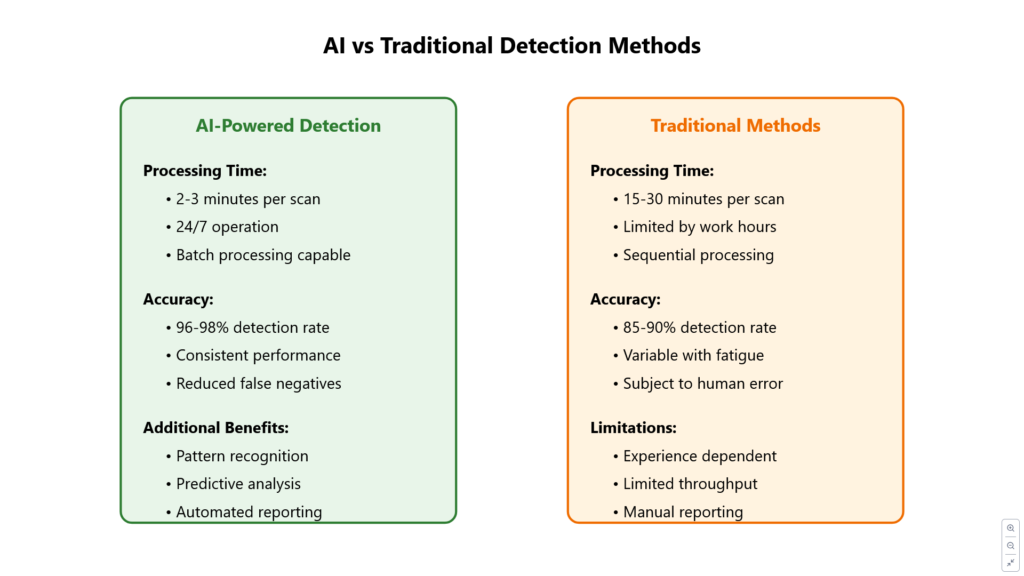In the rapidly evolving landscape of healthcare technology, artificial intelligence is revolutionizing how we detect and diagnose diseases. At the forefront of this transformation is AI-powered medical imaging, which is dramatically improving early disease detection and potentially saving countless lives.
The Revolution in Medical Imaging
Medical imaging has always been crucial in healthcare, but traditional methods rely heavily on human interpretation, which can be subject to fatigue, varying expertise levels, and the sheer volume of images requiring analysis. AI-powered systems are changing this paradigm by:
Enhanced Detection Capabilities
⦁ Processing thousands of images in minutes
⦁ Detecting subtle patterns invisible to the human eye
⦁ Providing consistent analysis 24/7
⦁ Reducing the risk of missed diagnoses
Improved Accuracy
⦁ Supporting radiologists with AI-driven insights
⦁ Reducing false positives and negatives
⦁ Offering quantitative analysis of imaging data
⦁ Standardizing interpretation across healthcare facilities

Figure 1: AI Medical Imaging Workflow A comprehensive visualization of the modern medical imaging process, from image acquisition through AI analysis to radiologist review.
Key Applications in Early Detection
When it comes to early disease detection, AI-powered medical imaging is making incredible strides. By leveraging advanced algorithms and vast datasets, AI systems can identify early signs of serious health conditions with remarkable accuracy. Here are some key applications in early detection that showcase the transformative potential of this technology:
1. Cancer Detection
⦁ Breast cancer screening through mammogram analysis
⦁ Lung nodule detection in chest X-rays
⦁ Skin cancer identification through dermoscopy
⦁ Brain tumor detection in MRI scans
2. Cardiovascular Disease
⦁ Early signs of heart disease in cardiac imaging
⦁ Arterial blockage detection
⦁ Valve abnormalities identification
⦁ Blood flow analysis
3. Neurological Conditions
⦁ Early detection of Alzheimer’s disease
⦁ Multiple sclerosis progression monitoring
⦁ Stroke risk assessment
⦁ Brain anomaly detection

Figure 2: AI vs Traditional Detection Methods Detailed comparison of AI-powered detection versus traditional methods, highlighting key differences in processing time, accuracy, and additional capabilities.
The Technology behind AI Medical Imaging
The success of AI in medical imaging is largely due to the sophisticated technology that powers it. By using deep learning algorithms and computer vision capabilities, AI systems can process and analyze medical images in ways that were previously unimaginable. Here’s a closer look at the technology behind AI medical imaging:
Deep Learning Algorithms
Complex neural networks trained on vast datasets of medical images enable:
⦁ Pattern recognition in medical scans
⦁ Automatic feature extraction
⦁ Abnormality detection
⦁ Risk prediction
Computer Vision Capabilities
Advanced image processing techniques allow for:
⦁ Multi-dimensional image analysis
⦁ Real-time processing
⦁ Automated measurements
⦁ Tissue characterization
Impact on Healthcare Delivery
AI-driven medical imaging technology is revolutionizing healthcare delivery, providing significant benefits for both healthcare providers and patients. Here’s how it’s making a difference:
⦁ Reduced workload on radiologists
⦁ Faster diagnosis and treatment planning
⦁ More efficient resource allocation
⦁ Better patient outcomes
⦁ Earlier disease detection
⦁ More accurate diagnoses
⦁ Reduced waiting times
⦁ Less invasive diagnostic procedures
Implementation Challenges and Solutions
While AI in medical imaging offers tremendous potential, its implementation comes with challenges. Addressing these effectively ensures successful adoption and integration. Here are some common challenges and their solutions:
Data Privacy and Security
⦁ Implementing robust security protocols
⦁ Ensuring HIPAA compliance
⦁ Protecting patient confidentiality
⦁ Secure data storage and transmission
Integration with Existing Systems
⦁ Seamless PACS integration
⦁ Workflow optimization
⦁ Staff training and adaptation
⦁ Quality assurance protocols
Future Developments and Trends
The field of AI in medical imaging is continuously evolving, with exciting new technologies and research directions emerging. Here’s a look at some future developments and trends to watch.
Emerging Technologies
⦁ Advanced 3D imaging analysis
⦁ Real-time diagnostic assistance
⦁ Automated reporting systems
Predictive analytics
Research Directions
⦁ Multi-modal imaging analysis
⦁ Personalized risk assessment
⦁ Treatment response prediction
⦁ Disease progression modeling
Best Practices for Implementation
Successfully implementing AI in medical imaging requires a strategic approach. Here are some best practices to ensure a smooth and effective transition:
1. Phased Approach
⦁ Start with pilot programs
⦁ Validate results against existing methods
⦁ Gather feedback from healthcare providers
⦁ Scale based on success metrics
2. Staff Training
⦁ Comprehensive training programs
⦁ Regular updates and workshops
⦁ Performance monitoring
⦁ Continuous improvement
3. Quality Assurance
⦁ Regular system validation
⦁ Performance benchmarking
⦁ Error tracking and correction
⦁ Continuous algorithm updates
ROI and Economic Impact
Implementing AI in medical imaging not only improves clinical outcomes but also offers significant economic benefits. Here’s how it impacts costs and healthcare savings:
Cost Benefits
⦁ Reduced diagnostic time
⦁ Lower repeat examination rates
⦁ Earlier intervention leading to better outcomes
⦁ Optimized resource utilization
Healthcare Savings
⦁ Reduced hospital stays
⦁ Prevention of late-stage complications
⦁ More efficient treatment planning
⦁ Better resource allocation
Conclusion
AI-powered medical imaging represents a significant leap forward in healthcare technology, offering unprecedented capabilities in early disease detection. As these systems continue to evolve and improve, they will become increasingly integral to healthcare delivery, ultimately leading to better patient outcomes and more efficient healthcare systems.

